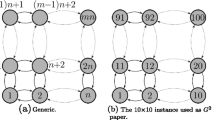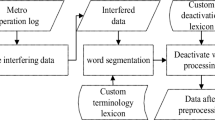Abstract
With increasing passenger flows and construction scale, metro systems in metropolises have entered a new era of networking operation and become the most effective way to alleviate and decrease traffic congestion. However, frequent occurrence of random failures and malicious attacks pose a serious threat to metro security and reliability. Thus, it is necessary to quantitatively evaluate the vulnerability of the metro network to different failures or attacks from a networking perspective. Based on the complex network theory, this study took the Shanghai Metro Network (SMN) as an example to investigate vulnerability of a weighted metro network in responding to random failures as well as malicious attacks. In particular, compared to topological networks, the vulnerability of weighted networks was analyzed to investigate how traffic and spatial constraints influence the transport system’s vulnerability, since topological features of complex networks are often associated with the weights of the edges and spatial constraints. Simulation results show that the SMN is robust against random failures but fragile for malicious attacks. The vulnerability analysis of weighted properties shows that all targeted attacks are capable to shatter the network’s communication or transport properties at a very low level of removed nodes and the highest betweenness attack strategy is the most effective mode to cause destructive effects on SMN among five attack or failure strategies. The inclusion of passenger flows provides evidence for the view that topological networks cannot convey all the information of a real-world network and traffic flow in the network should be considered as one of the key features in the finding and development of defensive strategies. Our results provide a richer view on complex weighted networks in real-world and possibilities of risk analysis and policy decisions for the metro operation department.

(Source: The website of Shanghai Shentong Metro Company)






Similar content being viewed by others
Explore related subjects
Discover the latest articles and news from researchers in related subjects, suggested using machine learning.References
Albert R, Barabási A-L (2002) Statistical mechanics of complex networks. Rev Mod Phys 74:47–97
Angeloudis P, Fisk D (2006) Large subway systems as complex networks. Physica A 367:553–558
Berche B, von Ferber C, Holovatch T, Holovatch Y (2009) Resilience of public transport networks against attacks. Eur Phys J B Condens Matter Complex Syst 71(1):125–137
Berche B, von Ferber C, Holovatch T, Holovatch Y (2010) Public transport networks under random failure and directed attack. Dyn Socio-Econ Syst 2(2):42–54
Berdica K (2002) An introduction to road vulnerability: what has been done, is done and should be done. Transp Policy 9:117–127
Berdica K, Mattsson LG (2007) Vulnerability: A Model-Based Case Study of the Road Network in Stockholm. In: Murray AT, Grubesic TH (eds) Critical Infrastructure. Advances in Spatial Science. Springer, Berlin, Heidelberg, pp 81–106
Boccaletti S, Latora V, Moreno Y, Chavez M, Hwang DU (2006) Complex networks: structure and dynamics. Phys Rep 424(4–5):175–308
Bruyelle JL, O’Neill C, El-Koursi EM, Hamelin F, Sartori N, Khoudour L (2014) Improving the resilience of metro vehicle and passengers for an effective emergency response to terrorist attacks. Saf Sci 62:37–45
Cats O, Jenelius E (2012) Vulnerability analysis of public transport networks: a dynamic approach and case study for Stockholm. In: The international symposium on transportation network reliability
Cats O, Yap M, Oort NV (2015) Exposing the role of exposure: identifying and evaluating critical links in public transport networks. In: The international symposium on transportation network reliability
Chopra SS, Dillon T, Bilec MM, Khanna V (2016) A network-based framework for assessing infrastructure resilience: a case study of the London metro system. J R Soc Interface 13(118):20160113
Crucitti P, Latora V, Marchiori M, Rapisarda A (2003) Efficiency of scale-free networks: error and attack tolerance. Physica A 320:622–642
Dall’Asta L, Barrat A, Vespignani L (2006) Vulnerability of weighted networks. J Stat Mech: Theory Exp 25(04):04006
De-Los-Santos A, Laporte G, Mesa JA, Perea F (2012) Evaluating passenger robustness in a rail transit network. Transport Res Part C Emerg Technol 20(1):34–46
Derrible S, Kennedy C (2010) The complexity and robustness of metro networks. Physica A 389(17):3678–3691
Ghedini CG, Ribeiro CH (2011) Rethinking failure and attack tolerance assessment in complex networks. Physica A 390:4684–4691
Guimerá R, Amaral LAN (2004) Modeling the world-wide airport network. Eur Phys J B Condens Matter Complex Syst 38(2):381–385
Han Y, Cheng H, Zhao X, Xue X (2012) Theoretic structure of urban mass transit operation safety based on vulnerability. Urban Mass Transit 15:15–19
Kyriakidis M, Hirsch R, Majumdar A (2012) Metro railway safety: an analysis of accident precursors. Saf Sci 50:1535–1548
Kyriakidis M, Hirsch R, Majumdar A (2014) A global safety analysis and best practice for metro railways. Soc Sci Electron Publ 166(6):362–374
Laporte G, Mesa JA, Perea F (2010) A game theoretic framework for the robust railway transit network design problem. Transport Res Part B Methodol 44(4):447–459
Luathep P, Sumalee A, Ho HW, Kurauchi F (2011) Large-scale road network vulnerability analysis: a sensitivity analysis based approach. Transportation 38(5):799–817
Mattsson LG, Jenelius E (2015) Vulnerability and resilience of transport systems—a discussion of recent research. Transport Res Part A Policy Pract 81:16–34
Motter AE, Lai Y-C (2003) Cascade-based attacks on complex networks. Phys Rev E: Stat Nonlinear Soft Matter Phys 66(6):114–129
Nawrath C (2006) Unraveling the complex network of cuticular structure and function. Curr Opin Plant Biol 9(3):281–287
Newman ME, Strogatz SH, Watts DJ (2001) Random graphs with arbitrary degree distributions and their applications. Phys Rev E 64:026118
Ouyang M, Zhao L, Hong L, Pan Z (2014) Comparisons of complex network based models and real train flow model to analyze Chinese railway vulnerability. Reliab Eng Syst Saf 123(3):38–46
Perea F, Puerto J (2013) Revisiting a game theoretic framework for the robust railway network design against intentional attacks. Eur J Oper Res 226(2):286–292
Petter H, Beom Jun K, No YC, Seung Kee H (2002) Attack vulnerability of complex networks. Phys Rev E 65(5):056109
Riedel HU (2014) Chinese metro boom shows no sign of abating. Int Railw J 54(11):46–48
Rodríguez-Núñez E, García-Palomares JC (2014) Measuring the vulnerability of public transport networks. J Transp Geogr 35:50–63
Sienkiewicz J, Hołyst JA (2005) Statistical analysis of 22 public transport networks in Poland. Phys Rev E Stat Nonlin Soft Matter Phys 72(4 Pt 2):046127
Taylor MAP, D’Este GM (2007) Transport network vulnerability: a method for diagnosis of critical locations in transport infrastructure systems. Critical infrastructure. Springer, Berlin, pp 9–30
von Ferber C, Holovatch T, Holovatch Y, Palchykov V (2007) Network harness: metropolis public transport. Physica A 380(7):585–591
Wang J (2013) Robustness of complex networks with the local protection strategy against cascading failures. Saf Sci 53:219–225
Wang J, Fang W (2014) A structured method for the traffic dispatcher error behavior analysis in metro accident investigation. Saf Sci 70:339–347
Wang J, Mo H, Wang F, Jin F (2011) Exploring the network structure and nodal centrality of China’s air transport network: a complex network approach. J Transp Geogr 19(4):712–721
Wang H, Huang J, Xu X, Xiao Y (2014) Damage attack on complex networks. Physica A 408:134–148
Xu Z, Sui DZ (2007) Small-world characteristics on transportation networks: a perspective from network autocorrelation. J Geogr Syst 9(2):189–205
Xu X, Hu J, Liu F (2007a) Scaling and correlations in three bus-transport networks of China. Physica A 374(1):441–448
Xu X, Hu J, Liu F (2007b) Empirical analysis of the ship-transport network of China. Chaos 17(2):471–516
Yang Y, Liu Y, Zhou M, Li F, Sun C (2015) Robustness assessment of urban rail transit based on complex network theory: a case study of the Beijing subway. Saf Sci 79:149–162
Yuan J, Li Q, Jia R, Wang Z (2012) Analysis of operation vulnerabilities of urban metro network system. China Saf Sci J 22:92–98
Zhang J, Xu X, Hong L, Wang S, Fei Q (2011) Networked analysis of the Shanghai subway network, in China. Physica A 390(23):4562–4570
Zhang J, Xu X, Hong L, Wang S, Fei Q (2012) Attack vulnerability of self-organizing networks. Saf Sci 50:443–447
Zhou Z, Irizarry J, Li Q (2014) Using network theory to explore the complexity of subway construction accident network (SCAN) for promoting safety management. Saf Sci 64:127–136
Acknowledgements
The authors thank the Shanghai Shentong Metro Company, for providing valuable information about the SMN for academic and research activities. In addition, the authors acknowledge the financial support of Project 71671127 by the National Natural Science Foundation of China.
Author information
Authors and Affiliations
Corresponding author
Rights and permissions
About this article
Cite this article
Xing, Y., Lu, J., Chen, S. et al. Vulnerability analysis of urban rail transit based on complex network theory: a case study of Shanghai Metro. Public Transp 9, 501–525 (2017). https://doi.org/10.1007/s12469-017-0170-2
Accepted:
Published:
Issue Date:
DOI: https://doi.org/10.1007/s12469-017-0170-2




